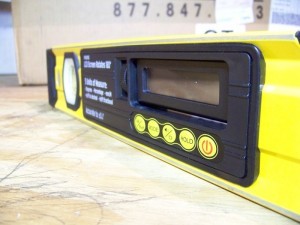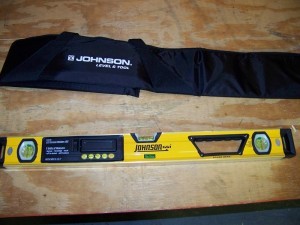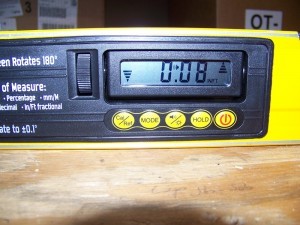I was very excited when I heard we were going to try the Johnson Level 40-6028 Digital Level. Over the years everyone told me I wasn’t levelheaded, so I figured with this new level, I could change things. Well just my luck, this is the one thing that the level cannot do, fix me. However it does make my work a lot easier.
Specifications of the Johnson Level
- LCD Screen that rotates 180 Degrees
- 5 Construction Languages
- Patented Glo-View Vial which enhances readability in low light – recharges by natural light
- 0 – 10 and 80-90 degree position of inclination is confirmed by signal tone
Having a level is just one of those tools that everyone needs, it’s like a hammer or screwdriver. Having a quality name like Johnson, just makes it that much sweeter. When we first received the level, we were pretty excited about trying this level as the other Johnson tools we tested were all pretty cool. The kit comes with the level, model 40-6028, 3 AAA batteries for the LCD screen, pouch and manual which was easy to understand.
Before we go on, we guess now is a nice time to talk about the accuracy of the level as that plays an important role of any good level. The accuracy of the level is ±0.1 deg for 0 deg and 90 deg and ±0.2 for all other angles.
The patented Glo-view works pretty well also. In all honesty when I first heard about it, I thought who is going to use this level in the dark, except my kids when they think it is a pretty cool sword and start breaking my tools and lamps. Then as we were playing with the level, not as a sword, but actually using it hanging some cabinets. One area was a little darker and that’s when the light actually proved me wrong. The Glo-View is actually not only cool looking, but comes in very handy. It was much easier to read.
Now let’s get into the meat and potatoes of the level, the LCD. Two things to note about the LCD screen is that it rotates 180 degrees for use on either side of the level and the numbers invert for overhead use. Below the LCD screen are 5 buttons to operate the LCD screen:
- Power Key – In case you haven’t guessed this turns on and off the power. The system will beep twice for on and once for off.
- Hold Key – Again if you haven’t guessed the hold feature allows you to hold an angle reading. Once you have your level in place, press the hold button and it will display on the LCD screen, even after you move the level. I am not the brightest pencil in the box, oh I mean the sharpest pencil in the box, so this is a cool feature. When you use the hold feature, the arrows on each side of the LCD screen blink to let you know you are in hold feature. That way you’re not trying to figure out why everything has the same reading.
- Sounds/LCD Illumination Key – This is a multi key. If you press and hold the button for three seconds, the back light will turn on or off. If you just press the button, you are able to turn the sound off and on. When the sound is on, you will see a little horn button to let you know the sound is on. If you are off by more than 10 degrees, you will not hear any beeping. As you get closer to the level being leveled, the beeps will get closer and once level, you will hear a constant sound.
- Mode Key – This is the cool key. The mode is what allows the user to select from 1 of 5 different construction languages. A user can pick what the LCD will show. You can choose from Degree, Percentage of slope, Millimeters per meter, inches per foot (slope, Pitch) in decimal form and inches per foot in fractions of an inch. Also to note on either side on the LCD there are arrows that lets the user easily know which way the slope is going and what direction you need to make it level.
- Zero Calibration Key – The level is self calibrating, but if you need to set the LCD to a new Zero reading at any angle, just use this button.
The unit will turn off in 15-20 minutes if no buttons are pressed to help save on battery life. However when the batteries do need replacing, the battery symbol will flash to let the user know to change the batteries.
Conclusion
Well the old thought that a level is just a level, no longer holds true. The Johnson level is pretty cool and has some easy to use and useful features. The digital display is not only cool, but very easy to work with and read. If you’re looking for a great level, we suggest taking a look at this Johnson digital level as it’s a great buy.
We always like to hear back from our readers on their experience with these tools – good or bad. Do you have experience with these tools? How has the long term use been? What applications have you used the tool for? Is this a DIY or professional grade tool? Let us and other readers know.





